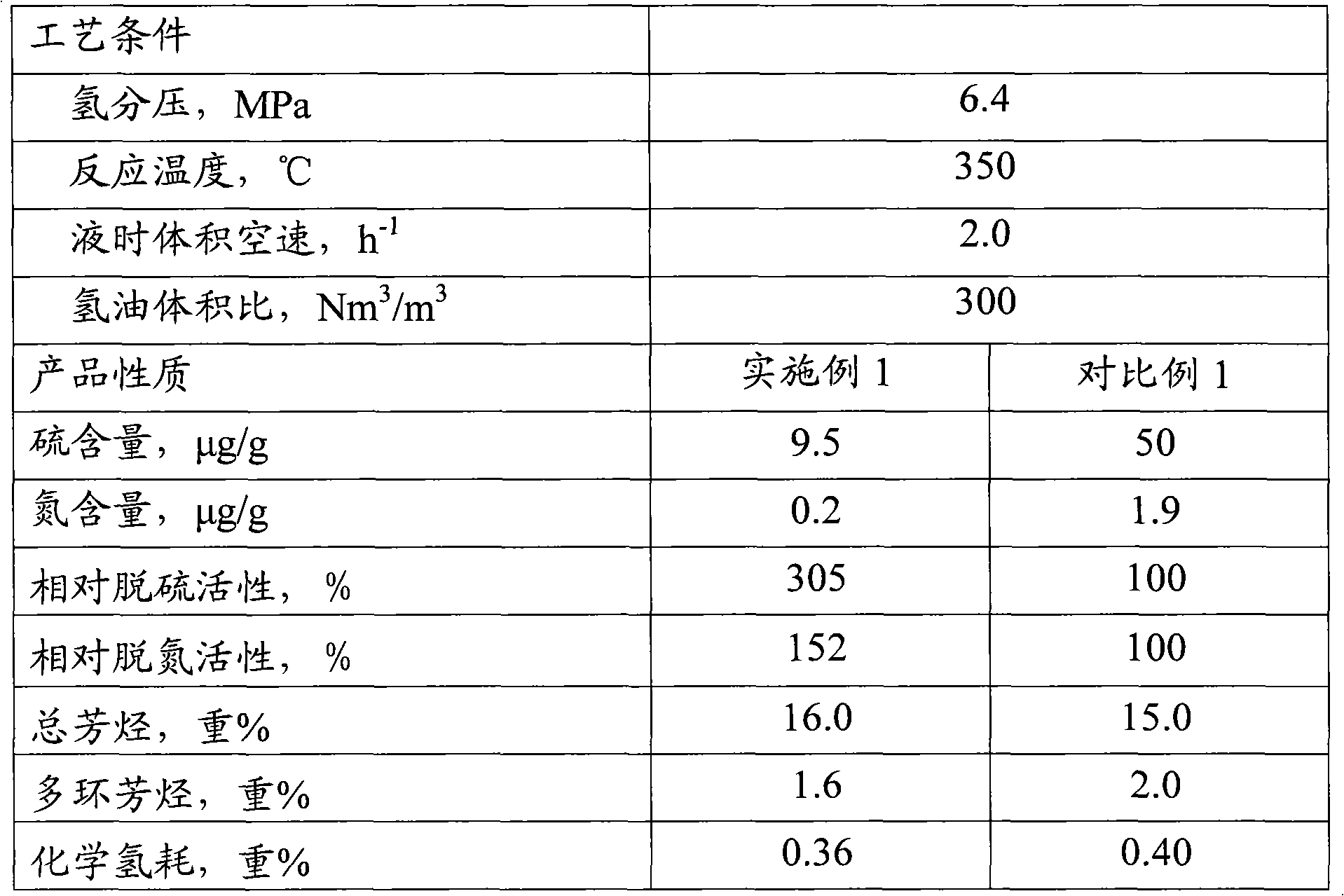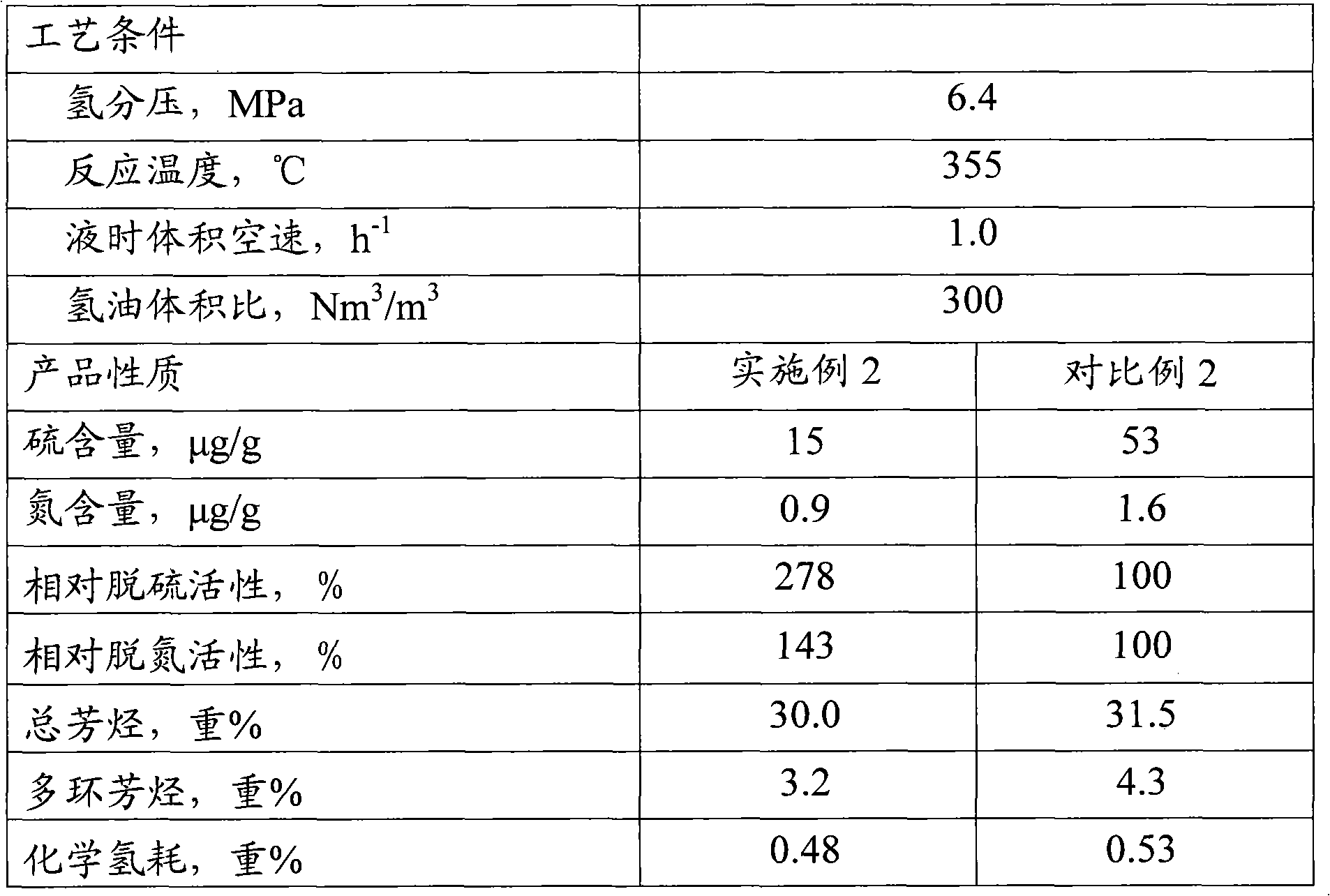Hydrogenation method for producing ultra-low sulfur clean diesel
An ultra-low-sulfur diesel technology, which is applied in the fields of hydrotreating process, chemical instruments and methods, and hydrocarbon oil treatment, can solve the problems of reducing diesel yield and increasing chemical hydrogen consumption, so as to improve economy, equipment investment and Low operating cost and reduced hydrogen consumption
- Summary
- Abstract
- Description
- Claims
- Application Information
AI Technical Summary
Problems solved by technology
Method used
Image
Examples
Embodiment 1
[0035] A high-sulfur straight-run diesel fraction from the Middle East is raw material A, and its properties are shown in Table 2. Raw material A is mixed with supplementary hydrogen and recycled hydrogen and then enters into the reactor equipped with two kinds of hydrofinishing catalysts. The reactor is divided into two catalyst beds, the upper part of the reactor is filled with hydrofinishing catalyst I, and the lower part of the reactor is filled with Hydrofinishing catalyst II, the loading ratio of the two hydrofinishing catalysts is 9:1 (volume ratio). Raw material A undergoes deep hydrodesulfurization reaction under the action of two hydrorefining catalysts. The reaction conditions are: reaction temperature 340°C, reaction hydrogen partial pressure 6.4MPa, liquid hourly volume space velocity 2.0h -1 , hydrogen oil volume ratio 300Nm 3 / m 3 . After the reaction product is cooled and separated, the obtained hydrogen-rich gas is recycled hydrogen. The obtained liquid pha...
Embodiment 2
[0042] A high-sulfur straight-run diesel fraction from the Middle East is mixed with a domestic catalytic cracking diesel fraction at a weight ratio of 1:1, and the obtained mixed diesel fraction is raw material B, and its properties are shown in Table 2. Raw material B is mixed with supplementary hydrogen and recycled hydrogen and then enters into the reactor equipped with two kinds of hydrofinishing catalysts. The reactor is divided into two catalyst beds, the upper part of the reactor is filled with hydrofinishing catalyst I, and the lower part of the reactor is filled with Hydrofinishing catalyst II, the loading ratio of the two hydrofinishing catalysts is 6:4 (volume ratio). Raw material B undergoes deep hydrodesulfurization reaction under the action of two hydrorefining catalysts. The reaction conditions are: reaction temperature 355°C, reaction hydrogen partial pressure 6.4MPa, liquid hourly volume space velocity 1.0h -1 , hydrogen oil volume ratio 300Nm 3 / m 3 . Aft...
Embodiment 3
[0049] A secondary processing catalytic cracking diesel fraction is raw material C, and its main properties are shown in Table 2. The raw material C is mixed with supplementary hydrogen and recycled hydrogen and then enters a reactor equipped with two hydrotreating catalysts. The reactor is divided into There are two catalyst beds, the upper part of the reactor is filled with hydrofinishing catalyst I, and the lower part of the reactor is filled with hydrofinishing catalyst II, and the filling ratio of the two hydrogenation catalysts is 3:7 (volume ratio). Raw material C undergoes deep hydrodesulfurization reaction under the action of two hydrorefining catalysts. The reaction conditions are: reaction temperature 340°C, reaction hydrogen partial pressure 6.4MPa, liquid hourly volume space velocity 2.0h -1 , hydrogen oil volume ratio 300Nm 3 / m 3 . After the reaction product is cooled and separated, the obtained hydrogen-rich gas is recycled hydrogen. The obtained liquid phase...
PUM
 Login to View More
Login to View More Abstract
Description
Claims
Application Information
 Login to View More
Login to View More - R&D
- Intellectual Property
- Life Sciences
- Materials
- Tech Scout
- Unparalleled Data Quality
- Higher Quality Content
- 60% Fewer Hallucinations
Browse by: Latest US Patents, China's latest patents, Technical Efficacy Thesaurus, Application Domain, Technology Topic, Popular Technical Reports.
© 2025 PatSnap. All rights reserved.Legal|Privacy policy|Modern Slavery Act Transparency Statement|Sitemap|About US| Contact US: help@patsnap.com



